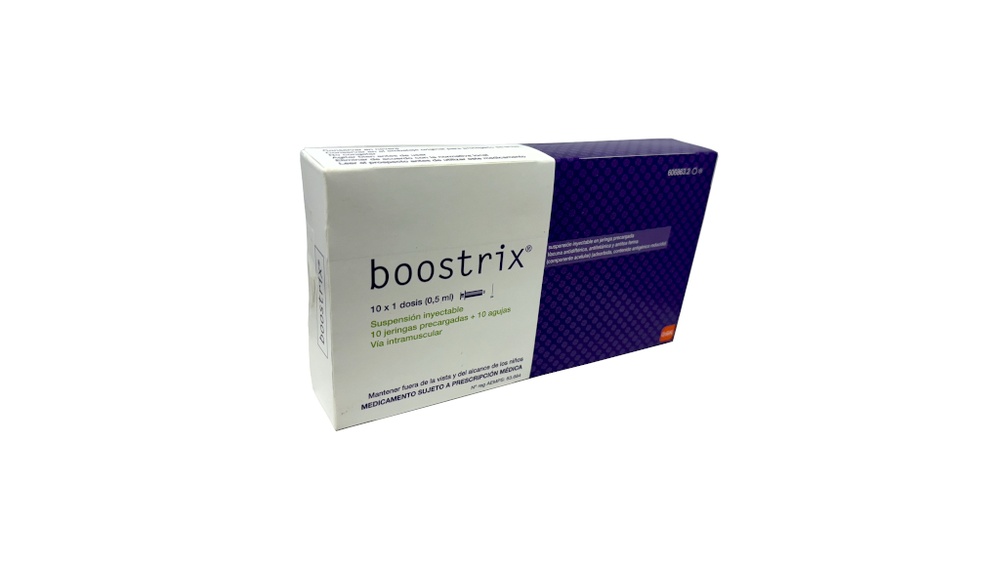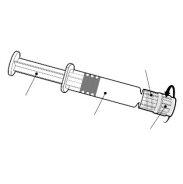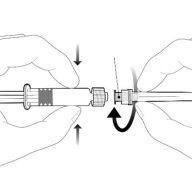

BOOSTRIX SUSPENSION FOR INJECTION IN PRE-FILLED SYRINGE

Ask a doctor about a prescription for BOOSTRIX SUSPENSION FOR INJECTION IN PRE-FILLED SYRINGE

How to use BOOSTRIX SUSPENSION FOR INJECTION IN PRE-FILLED SYRINGE
Introduction
Package Leaflet: Information for the User
Boostrix, Suspension for Injection in a Pre-filled Syringe
Diphtheria, Tetanus and Pertussis (Acellular Component) Vaccine (Adsorbed, Reduced Antigen Content)
Read all of this leaflet carefully before you or your child receive this vaccine, because it contains important information for you.
- Keep this leaflet, you may need to read it again.
- If you have any further questions, ask your doctor or pharmacist.
- This vaccine has been prescribed for you or your child, do not pass it on to others.
- If you or your child experience any side effects, talk to your doctor or pharmacist, even if they are not listed in this leaflet. See section 4.
Contents of the Package Leaflet
- What is Boostrix and what is it used for
- What you need to know before you or your child receive Boostrix
- How to use Boostrix
- Possible side effects
- Storage of Boostrix
- Package Contents and Further Information
1. What is Boostrix and what is it used for
Boostrix is a vaccine indicated for booster vaccination in children from 4 years of age, adolescents and adults to prevent three diseases: diphtheria, tetanus and pertussis. The vaccine works by helping the body to produce its own protection (antibodies) against these diseases.
- Diphtheria:diphtheria mainly affects the respiratory tract and sometimes the skin. The respiratory tract usually becomes inflamed (swollen) causing severe breathing difficulties and sometimes asphyxia. The bacteria also release a toxin (poison) that can cause nerve damage, heart problems and even death.
- Tetanus (lockjaw):tetanus bacteria enter the body through cuts, scratches or wounds in the skin. Wounds that are particularly prone to infection are burns, fractures, deep wounds or wounds contaminated with dirt, dust, horse manure or wood splinters. The bacteria release a toxin (poison) that can cause muscle stiffness, painful muscle spasms, convulsions and even death. The muscle spasms can be so strong that they cause fractures of the spine.
- Pertussis:pertussis is a highly infectious disease. The disease affects the respiratory tract, causing severe coughing attacks that can interfere with normal breathing. The cough is often accompanied by a "whoop" hence the common name whooping cough. The cough can last 1-2 months or longer. It can also cause ear infections, bronchitis that can last a long time, pneumonia, convulsions, brain damage and even death.
None of the vaccine components can cause diphtheria, tetanus or pertussis.
The use of Boostrix during pregnancy will help protect your baby from pertussis in the first months of life, before they receive their primary immunization.
2. What you need to know before you or your child receive Boostrix
Boostrix must not be administered:
- if you or your child have previously had any allergic reaction to Boostrix or any of the other components of this vaccine (listed in section 6) or to formaldehyde. The signs of an allergic reaction may include skin rash with itching, difficulty breathing and swelling of the face or tongue.
- if you or your child have previously had an allergic reaction to any vaccine against diphtheria, tetanus or pertussis.
- if you or your child have had problems in the nervous system (encephalopathy) in the 7 days following a previous vaccination with a pertussis vaccine.
- if you or your child have had a severe infection with a high temperature (over 38 °C). A minor infection should not be a problem, but consult your doctor first.
- if you or your child have had a temporary reduction in blood platelets (which increases the risk of bleeding or bruising) or brain or nervous system problems after a previous vaccination with a diphtheria and/or tetanus vaccine.
Warnings and precautions
Consult your doctor or pharmacist before you or your child receive Boostrix:
- if you or your child have had any problems after a previous administration of Boostrix or another pertussis vaccine, especially:
- Fever (over 40 °C) in the 48 hours following vaccination.
- Collapse or shock-like state in the 48 hours following vaccination.
- Persistent, inconsolable crying lasting more than 3 hours, occurring within 48 hours of vaccination.
- Convulsions, with or without fever, occurring within 3 days of vaccination.
- if your child has an undiagnosed or progressive brain disease or uncontrolled epilepsy. The vaccine should be administered once the disease is under control
- if you or your child have bleeding problems or bruise easily
- if you or your child have a tendency to have febrile seizures or if there is a family history of this
- if you or your child have persistent immune system problems due to any cause (including HIV infection). You or your child may still receive Boostrix, but the protection against infections after vaccination may not be as good as in patients with adequate immune responses to infections.
Before or after any injection, fainting (especially in adolescents) may occur, so you should inform your doctor or nurse if you or your child have fainted after receiving an injection in the past.
As with all vaccines, Boostrix may not provide complete protection in all vaccinated patients.
Use of Boostrix with other medicines
Tell your doctor or pharmacist if you or your child are using, have recently used or might use any other medicines or if you have recently received any other vaccine.
Boostrix can be administered at the same time as other vaccines. A different injection site should be used for each type of vaccine. Boostrix may not provide an adequate response if you or your child are taking medicines that reduce the effectiveness of your immune system against infections.
Pregnancy and breastfeeding
If you are pregnant or breastfeeding, think you may be pregnant or plan to become pregnant, consult your doctor or pharmacist before receiving this vaccine.
No data are available on whether Boostrix passes into breast milk. Your doctor will inform you of the possible risks and benefits of administering Boostrix during breastfeeding.
Driving and using machines
It is unlikely that Boostrix will have any effect on the ability to drive or use machines.
Boostrix contains sodium
This medicine contains less than 23 mg of sodium (1 mmol) per dose unit; this is essentially "sodium-free".
3. How to use Boostrix
- Boostrix will be administered as an injection into the muscle.
- The vaccine must never be administered intravenously.
- You or your child will receive a single injection of Boostrix.
- Your doctor will check if you or your child have previously received diphtheria, tetanus and/or pertussis vaccines.
- Boostrix can be used in case of suspected tetanus infection, although other measures to reduce the risk of disease manifestation, such as wound care and/or tetanus antitoxin, should also be taken.
- Your doctor will recommend repeating the vaccination.
4. Possible side effects
Like all medicines, this vaccine can cause side effects, although not everybody gets them.
As with all injectable vaccines, serious allergic reactions (anaphylactic and anaphylactoid reactions) may occur very rarely (up to a maximum of 1 in 10,000 doses of the vaccine). These can be recognized by:
- Skin rashes such as itching or hives,
- Swelling of the eyes and face,
- Difficulty breathing or swallowing,
- Sudden drop in blood pressure and loss of consciousness.
These reactions can occur before leaving the doctor's office. However, if you notice any of these symptoms in you or your child, contact a doctor immediately.
Side effects that occurred during clinical trials in children from 4 to 8 years of age
Very common(may occur with more than 1 in 10 doses of the vaccine): pain, redness and swelling at the injection site, irritability, feeling of sleepiness, tiredness.
Common(may occur with up to 1 in 10 doses of the vaccine): loss of appetite, headache, fever of 37.5 °C or higher (including fever over 39 °C), extensive swelling of the limb where the vaccine was administered, vomiting and diarrhea.
Uncommon(may occur with up to 1 in 100 doses of the vaccine): upper respiratory tract infection, attention disorders, itchy eye and eyelid discharge with crust (conjunctivitis), skin rash, induration at the injection site, pain.
Side effects that occurred during clinical trials in adults, adolescents and children from 10 years of age
Very common(may occur with more than 1 in 10 doses of the vaccine): pain, redness and swelling at the injection site, headache, tiredness, general feeling of being unwell.
Common(may occur with up to 1 in 10 doses of the vaccine): fever of 37.5 °C or higher, dizziness, nausea, induration and abscess at the injection site.
Uncommon(may occur with up to 1 in 100 doses of the vaccine): fever over 39 °C, pain, muscle and joint stiffness, vomiting, diarrhea, joint stiffness, joint pain, muscle pain, itching, excessive sweating (hyperhidrosis), skin rash, swelling of the lymph nodes in the neck, armpits or groin (lymphadenopathy), sore throat and difficulty swallowing (pharyngitis), upper respiratory tract infection, cough, fainting (syncope), flu-like symptoms such as fever, sore throat, runny nose, cough and chills.
The following side effects occurred during routine use of Boostrix and are not specific to any age group: swelling of the face, lips, mouth, tongue or throat that can cause difficulty swallowing or breathing (angioedema), collapse or loss of consciousness, seizures or fits (with or without fever), hives (urticaria), unusual weakness (asthenia).
After administration of tetanus vaccines, cases of temporary nerve inflammation have been reported very rarely (up to a maximum of 1 in 10,000 doses of vaccine), which can cause pain, weakness and paralysis in the limbs and can sometimes spread to the chest and face (Guillain-Barré syndrome).
Reporting of side effects
If you or your child experience any side effects, talk to your doctor or pharmacist, even if they are not listed in this leaflet. You can also report side effects directly through the Spanish Medicines Monitoring System for Human Use, www.notificaRAM.es. By reporting side effects, you can help provide more information on the safety of this medicine.
5. Storage of Boostrix
Keep this vaccine out of the sight and reach of children.
Do not use this vaccine after the expiry date stated on the packaging and on the label of the pre-filled syringe after EXP. The expiry date is the last day of the month shown.
Store in a refrigerator (between 2 °C and 8 °C).
Do not freeze. Freezing destroys the vaccine.
Store in the original packaging to protect from light.
Medicines should not be disposed of via wastewater or household waste. Return the packaging and any unused medicine to a pharmacy for disposal. If you are unsure, ask your pharmacist how to dispose of the packaging and any unused medicine. This will help protect the environment.
6. Package Contents and Further Information
Composition of Boostrix
- The active substances are:
Diphtheria toxoid1 at least 2 International Units (IU) (2.5 Lf)
Tetanus toxoid1 at least 20 International Units (IU) (5 Lf)
Bordetella pertussisantigens
Pertussis toxoid1 8 micrograms
Filamentous haemagglutinin1 8 micrograms
Pertactin1 2.5 micrograms
1adsorbed on hydrated aluminium hydroxide (Al(OH)3) 0.3 milligrams Al3+
and aluminium phosphate (AlPO4) 0.2 milligrams Al3+
Aluminium hydroxide and aluminium phosphate are included in the vaccine as adjuvants.
Adjuvants are substances included in certain vaccines to accelerate, improve and/or prolong the protective effect of the vaccine.
- The other ingredients are: sodium chloride and water for injections.
Appearance of the Product and Package Contents
Injectable suspension in a pre-filled syringe.
Boostrix is a white, slightly cloudy liquid presented in a pre-filled syringe (0.5 ml).
Boostrix is available in a pre-filled syringe with or without separate needles; pack sizes of 1 and 10.
Not all pack sizes may be marketed.
Marketing Authorisation Holder and Manufacturer
Marketing Authorisation Holder
GlaxoSmithKline, S.A.
P.T.M. C/ Severo Ochoa, 2
28760 Tres Cantos
(Madrid)
Tel: 900 202 700
Manufacturer
GlaxoSmithKline Biologicals S.A.
Rue de l'Institut 89; 1330 Rixensart
Belgium
Date of Last Revision of this Leaflet:April 2023
Other Sources of Information
Detailed information on this medicine is available on the website of the Spanish Agency for Medicines and Health Products (AEMPS) (http://www.aemps.gob.es/).
------------------------------------------------------------------------------------------------------------------
This information is intended only for healthcare professionals:
Before administration, the vaccine should be at room temperature and shaken well to obtain a white, cloudy and homogeneous suspension, and should be visually inspected for any foreign particles and/or changes in physical appearance before administration. If any of these circumstances are observed, do not administer the vaccine.
Instructions for the pre-filled syringe
| Hold the syringe by the body, not by the plunger. Remove the syringe cap by twisting it in a counter-clockwise direction. |
| To insert the needle, attach the base to the Luer-Lock adapter and twist it a quarter turn in a clockwise direction until it clicks. Do not pull the plunger out of the syringe body. If this happens, do not administer the vaccine. |
Disposal of waste:
Disposal of unused medicine and all materials that have come into contact with it should be done in accordance with local regulations.
- Country of registration
- Active substance
- Prescription requiredYes
- Manufacturer
- This information is for reference only and does not constitute medical advice. Always consult a licensed doctor before taking any medication. Oladoctor is not responsible for medical decisions based on this content.
- Alternatives to BOOSTRIX SUSPENSION FOR INJECTION IN PRE-FILLED SYRINGEDosage form: INJECTABLE, 1 doseActive substance: pertussis, purified antigen, combinations with toxoidsManufacturer: Sanofi Winthrop IndustriePrescription requiredDosage form: INJECTABLE, 0.5 ml single doseActive substance: meningococcus B, multicomponent vaccineManufacturer: Glaxosmithkline Vaccines S.R.L.Prescription requiredDosage form: INJECTABLE, 0.5 ml single doseActive substance: meningococcus B, multicomponent vaccineManufacturer: Glaxosmithkline Vaccines S.R.L.Prescription required
Alternatives to BOOSTRIX SUSPENSION FOR INJECTION IN PRE-FILLED SYRINGE in other countries
The best alternatives with the same active ingredient and therapeutic effect.
Alternative to BOOSTRIX SUSPENSION FOR INJECTION IN PRE-FILLED SYRINGE in Polonia
Alternative to BOOSTRIX SUSPENSION FOR INJECTION IN PRE-FILLED SYRINGE in Ucrania
Online doctors for BOOSTRIX SUSPENSION FOR INJECTION IN PRE-FILLED SYRINGE
Discuss dosage, side effects, interactions, contraindications, and prescription renewal for BOOSTRIX SUSPENSION FOR INJECTION IN PRE-FILLED SYRINGE – subject to medical assessment and local rules.





















